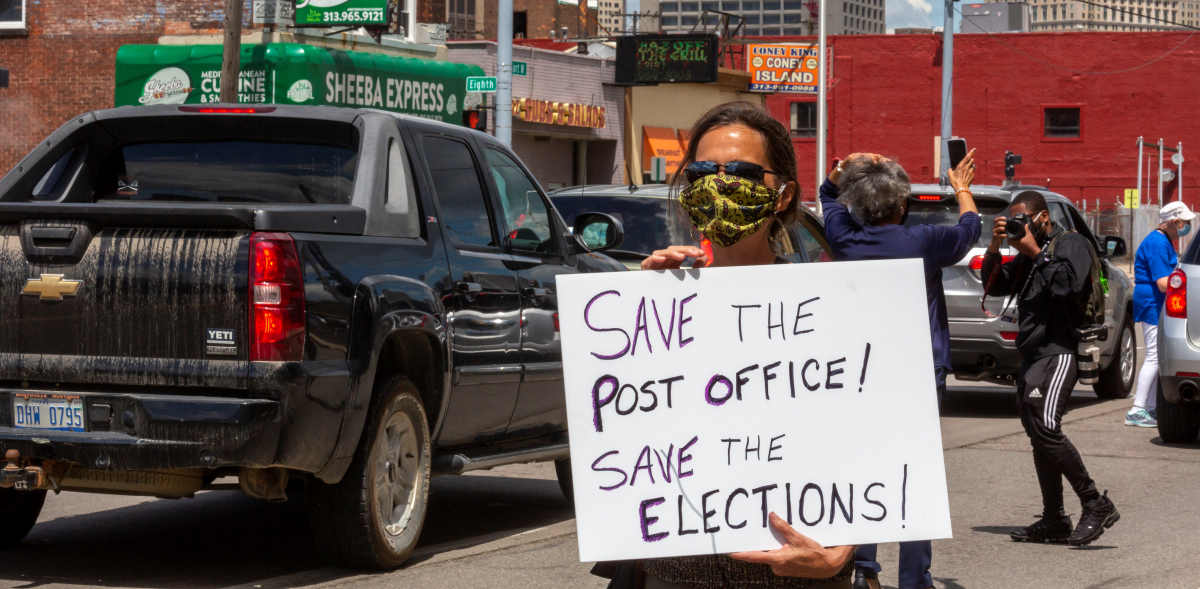The story of mail ballots in 2020 is the story of a union postal workforce willing to go to extraordinary lengths to make sure that every vote got delivered.
Postal workers did this despite the deliberate holdups created by new Postmaster General Louis “Delay the Mail” DeJoy, and a workforce hit hard by COVID.
A Better USPS
Postmaster General Louis DeJoy claims the Postal Service has an “unsustainable business model.” He wants to slash 64 million work hours next year.
But his plan isn’t the only one on offer. A working group of rank and filers has compiled all the ways his vision is antithetical to what the public needs.
To imagine a green, expanded, universal Postal Service with more hours, more services, and more good jobs, visit bit.ly/postalvision.
More than 65 million people voted by mail this fall—a record. And the Postal Service has been working at reduced numbers for months. As of August 40,000 postal employees had been forced to quarantine. Roscoe Woods, president of the 480–481 Area Local of the Postal Workers (APWU) near Detroit, said the workforce he represents is down 30 percent.
How did postal workers pull off this gargantuan feat? “Most of our employees were very prideful,” said Keith Combs, president of the APWU Detroit local. “They were really happy they were able to complete the mission with the ballots. They want the Post Office to be seen in a different light than the White House had been portraying it.”
ABOVE AND BEYOND
Woods represents workers at the Michigan Metroplex in Pontiac, the largest mail processing facility in the region. On a normal day it processes a couple of million pieces of mail. How did workers make sure the ballots didn’t get lost in that fast-moving stream?
The mail is sorted at 36,000 pieces per hour by giant machines that read the envelopes. Before the election, workers set the machine to direct ballots to a designated holdout, then took them to another area for special manual sorting. Experienced clerks hand-sorted the ballots to county clerks’ zip codes. From there they were dispatched by truck.
Workers went further. “Say a ballot arrives in Flint but it was supposed to go to Muskegon,” Woods said. “Our people were meeting people in the middle to hand them off. I checked in with my plant manager the day of the election at a quarter to 8 [when polls closed]. He had just sent a supervisor out with 10 ballots to drop off at the Clerk’s office.
“Whatever was necessary. Our people rose to the occasion. It’s not every day you become an active participant in a functioning democracy.”
GET THE CROOK OUT?
All year postal workers have been under attack by the Postmaster General, a Trump fundraiser and expert job-killer from private logistics. Hundreds of mail sorting machines were dismantled; overtime was denied; letter carriers were directed not to sort all their mail when received, but to leave it behind for the next day.
It was only an outcry from postal unions and the public that forced DeJoy to say, on August 18, that he would postpone his service cuts till after the election. But he made clear he was only hitting pause.
Contrary to what you might assume, DeJoy and his schemes won’t automatically be swept out by a new administration. The men who hired him, and could fire him, are the Postal Board of Governors.
Unfortunately, the six current members are mostly anti-worker and pro-privatization. There are three empty seats that Joe Biden could fill immediately—except that any appointments must be confirmed by the Senate.
One promising strategy is to pressure the existing Board members, who aren’t used to a public spotlight. New Orleans activists got the ball rolling in October with a neighborhood “Cook Out to Get the Crook Out” near the home of one Postal Board member. Other members are in New York City, Los Angeles, eastern Kentucky, Palm Beach, and D.C.—for those similarly inspired.
Jane Slaughter is a former editor of Labor Notes. This piece was first published in The Detroit Socialist.






